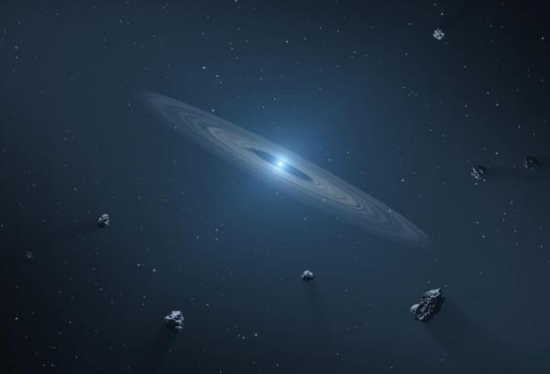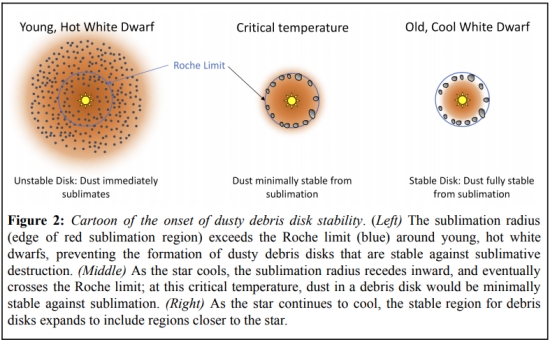You can blame H. G. Wells’ The Time Machine for my interest in the Earth’s far future. That swollen red Sun at the end of the novel created vivid ‘end of the world’ scenarios for me as a boy, and later I would learn that outer planets or moons around a G-class star might turn habitable once it became a red giant. But it would only be in the last few years that I learned how robust the investigations into white dwarf systems — the fate of a red giant — have become, and now we’re finding out not only that such stars can retain planets, but can conceivably create new ones through an emerging disk packed with the pulverized dust of remnant materials like asteroids.

Image: This artist’s concept shows a white dwarf debris disk. Credit: NASA/JPL-Caltech.
Jordan Steckloff (Planetary Science Institute, Tucson) has just published a short paper on the matter, looking at how white dwarf debris disks emerge. The disks seem to form only after ten to twenty million years following the end of the red giant phase. And a turbulent phase it is, with stars like the Sun losing a large proportion of their mass before they turn into a white dwarf. The dwarf itself is Earth-sized and only about half as massive as the star that gave birth to it.
The process of mass loss and collapse into a white dwarf exerts a destabilizing effect on those planets that have not already been swallowed up by the red giant (Mercury, Venus, and most likely Earth will be lost this way). Whether or not planets beyond a few AU of the star survive, their disrupted orbits can result in turmoil within the asteroid population of the system, with some of them falling toward the dwarf star, to be pulverized into dust by these gravitational interactions. Steckloff and team noticed the fact that a process of debris disk formation which ought to occur quickly takes shape only after the delay mentioned above. What is it that is holding back the formation of a debris disk for millions of years? The scientist explains:
“We found that this delay is a result of these young white dwarfs being extremely hot. So hot that any dust that forms from a tidally disrupted asteroid rapidly vaporizes and dissipates. We found that this dust only stops vaporizing after the white dwarf has had time to sufficiently cool down, to a surface temperature of approximately 27,000 degrees kelvin (48,000 degrees Fahrenheit). This temperature agrees with observations of these white dwarf systems; all dusty debris disks are found around white dwarfs cooler than this critical temperature.”

Image: This is Figure 2 from the paper. Credit: Steckloff et al.
Thus our own Solar System, several billion years down the road, should see the Sun enter its red giant phase and ultimately be trasformed into a white dwarf, with the result, according to Steckloff, that Jupiter will migrate outward, thoroughly disrupting the asteroid belt and sending enough of the asteroids close to the Sun to begin the formation of a dusty debris disk. While it is true that the formation process of a debris disk like this should favor hot young stars, whose planetary systems are more unstable, the dwarf star must cool first to the needed temperatures.
Steckloff’s material sublimation model shows the interplay of thermal and tidal forces within the regions around a white dwarf where dusty debris disks can form. The temperatures involved vary somewhat depending on the size of the white dwarf, with more massive stars forming disks at somewhat warmer temperatures. There is also the interesting twist that extremely cool white dwarfs may have more than one debris disk. We see this is a system tagged LSPM J0207+3331, which may be hosting disks formed from the disruption of two planetesimals.
This is the coldest, oldest white dwarf known with a dusty debris disk, according to the paper, and there appears to be a gap within the disk which can also be explained another way:
The apparent gap in this disk is curious and unexpected, and, analogous to protoplanetary disks, may point to the presence of a dense planet clearing a gap along its orbit from within the disk (as proposed for the SDSS J122859.93+104032.9 system; Manser et al. 2019) or a planet sitting outside the Roche limit opening a gap via resonant dynamics. Similar dynamical processes may be at work in dusty debris disks around white dwarfs and the ~3 Gyr cooling age of this white dwarf provides ample time for such dynamical processes to occur.
Whichever possibility is true, this system demonstrates that the environment around white dwarf stars appears to be a lively one. The paper gives us insight into how the physical processes at work restrict the formation of dusty debris disks to white dwarfs that have sufficiently cooled.
The paper is Steckloff et al., “How Sublimation Delays the Onset of Dusty Debris Disk Formation around White Dwarf Stars,” Astrophysical Journal Letters Vol. 913, No. 2 (2021), L31. Abstract / Preprint.



The reason the sun was so swollen in The Time Machine was not that it was a red giant. It was, if anything, smaller than now but the Earth’s orbit had decayed through friction and it was spiraling in. Mercury had already fallen into the sum (it made a brief flare-up as the Time Machine sped into Futurity) and Venus eclipsed the sun as the Time Traveler watched.
The odd thing about his prediction is that the dominant theories of star formation in the 1890s conceived of constant contraction from nebulae to red dwarfs. Expansion against gravity was not suggested until the 1930s (Stromgren/Kuiper etc) Russell circa 1911-1913 envisioned the contraction scenario as first a heating process to the main sequence, and then a cooling when the star was no longer in an ideal gas state. What Wells may have envisioned was not a bloated sun, but an earth (and other planets) migrating inwards over time due to loss of energy due to friction with interplanetary gas and dust, though that was wildly speculative too. Poynting mildly suggested this in 1904 I think.
Interesting! Thanks to both of you for the clarification. Dr. DeVorkin has written about this matter in a paper titled “The Changing Place of Red Giant Stars in the Evolutionary Process”:
http://articles.adsabs.harvard.edu/pdf/2006JHA….37..429D
and also in his biography of Henry Norris Russell:
https://www.amazon.com/Henry-Norris-Russell-David-DeVorkin/dp/0691049181/ref=sr_1_7?dchild=1&keywords=david+devorkin&qid=1622798120&s=books&sr=1-7
The first extra-solar planets detected had a more bizarre origin that the white dwarf planets as they orbit a neutron star:
https://astronomy.com/news/2019/10/how-the-first-exoplanets-were-discovered
A breakthrough in 1992 provided rock-solid evidence of planets. Astronomers Aleksander Wolszczan and Dale Frail tuned into the pulsar PSR B1257+12, 2300 light-years away. It should have pulsed every 0.006219 seconds, but every now and then, its pulses were a little off. Yet those off-beats came at regular intervals as well. After intensive study, Wolszczan and Frail came up with an explanation for why that was: it had two planets around it. One was three and the other four times the mass of Earth, and they rotated around every 67 and 98 days, rounded up.
Pulsar planets are somewhere in between a zombie and a chimera. When a star explodes, usually the planets in that system are destroyed or flung out by a shockwave. But after the violence settles down, the gas and dust can recondense. This, in effect, means that the three planets in B1257 may be made out of parts of the planets that came before them. Given the extreme radiation in these systems, almost no one has ever thought that the B1257 system could host life.
Bet the sunrise is really awesome. Judging by the orbital period, they orbit at a distance similar to Mercury assuming that the neutron star’s mass is not much higher than the sun. Wonder what the surface temperatures are.
Sunny with a chance of gamma radiation.
You would have too take a lead umbrella with you just in case and with the mass of these worlds you would need strong arms and a back of iron !
Hi Paul
Some nice background comments from other readers covering the Solar evolution sequence of the 19th Century. The thought that there was significant friction determining the orbital evolution of the Inner Planets was more correct than they knew. The later phases of the Sun’s Red Giant phase will feature high levels of tidal drag, dooming Venus and the Earth, even if they escape the maximum extension of the Sun’s radius. The mass-loss rate is also strongly dependent on the opacity of the Red Giant’s outer atmosphere and may yet drag Mars and our asteroid belt in closer.
From a Dysonian SETI perspective let’s ponder this – the doom of the planets assumes they stay where they are presently for the next few aeons. And the Sun remains untouched. The Sun will only fuse about 10% of its available hydrogen during the Main Sequence. The rest will be rapidly used up when the Sun goes off the Main Sequence and bloats into Red Giant status, then a bit slower during its Helium Main Sequence before the Asymptotic Giant Branch (if it has one.) That race to oblivion is driven by the lack of convection in the Core. One observable for SETI might be stars showing signs of mass loss or other efforts to induce convective overturn in intermediate mass stars.
Someone proposed moving the Earth to a larger orbit over millions of years to keep things comfy. It involved a mediumish asteroid (100 miles in diameter?) using close passes of the Earth and an outer planet (Jupiter?) to transfer momentum. The asteroid’s orbit would need adjustments but the energy to do such would be a tiny fraction of the energy it would otherwise take to enlarge Earth’s orbit. Perhaps the asteroid could use massive light sails (thousands of square miles) to make the necessary adjustment and be fully automated. You how congress is, they have trouble funding a program whenever the administration changes.
Over time the moon can be used as well. The sun and any local solar collectors can be used to accelerate material from the moon and use it to move the Earth. We can slowly move out as the sun gets more luminous saving Earth awhile longer.
The Gravity Tractor concept can avoid asteroid Near-Misses by using the Moon as the tractor mass and parking a big solar sail in the right place. A BIG solar sail.
What I meant was a mass beam accelerator using solar energy. Rock can be ground to a fine powder, given a high electric charge and then highly accelerated providing a thrust.